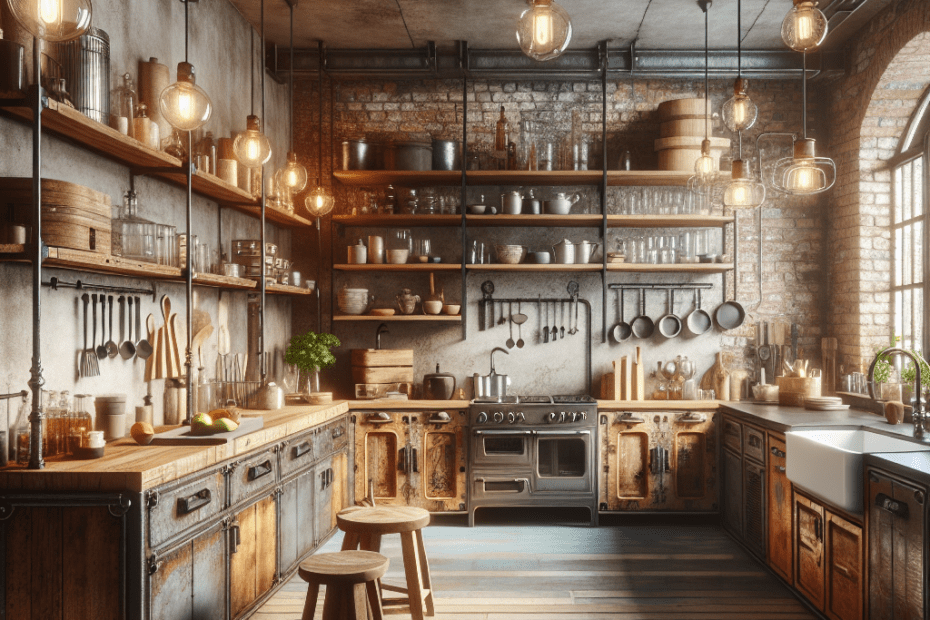“`html
How to Create a Rustic Industrial Kitchen
In recent years, the rustic industrial kitchen style has gained popularity among homeowners and interior designers alike. The charm of this design lies in its perfect blend of ruggedness and warmth, combining elements like exposed brick, raw wood, and metal. Crafting a rustic industrial kitchen is all about balancing aesthetics with functionality.
Understanding the Rustic Industrial Style
The rustic industrial kitchen style is a marriage of two seemingly opposite aesthetics that create a unique and inviting space. By combining the raw, edgy elements of industrial design with the warmth and comfort of rustic charm, homeowners can create a kitchen that is both practical and visually appealing.
Semantically Related Keywords
- Industrial design
- Rustic decor
- Exposed beams
- Raw wood finishes
- Metal accents
Key Features of a Rustic Industrial Kitchen
To achieve the rustic industrial kitchen look, they should focus on several key features:
| Element | Description |
|---|---|
| Exposed Brick | Brings an urban, industrial feel that is foundational to the style. It adds texture and color to the space. |
| Wooden Elements | Incorporate reclaimed or distressed wood for countertops, cabinets, and shelving, adding warmth and a sense of history. |
| Metal Accents | Use metals like steel, copper, or iron in fixtures, light fittings, and handles to complement the industrial vibe. |
| Neutral Color Palette | Use grays, whites, blacks, and browns to maintain an earthy and cohesive look throughout the kitchen. |
Step-by-Step Guide to Creating a Rustic Industrial Kitchen
1. Planning the Layout
They should begin by considering the layout of their kitchen. An open floor plan is ideal for a rustic industrial kitchen as it allows the elements to shine. According to a study by the National Kitchen & Bath Association, 70% of new kitchen projects follow an open-plan layout. This design choice provides ample space for incorporating large islands and communal areas.
2. Choosing Materials
For an authentic look, they should opt for reclaimed materials. This not only contributes to a rustic feel but is also environmentally friendly. Using recycled wood and metal can drastically reduce carbon footprint while giving the kitchen a unique character. The Environmental Protection Agency (EPA) suggests that incorporating recycled materials is a significant step toward sustainability in home design.
3. Adding Essential Features
- Shelving: Open shelves made of wood and metal add to the industrial look while providing practical storage solutions.
- Lighting: Pendant lights with metal finishes are ideal. They can choose Edison bulbs to enhance the rustic charm.
- Furniture: Metal stools or chairs paired with a wooden table can complete the look, offering functionality and style.
4. Final Touches
Finally, they should focus on the smaller details that tie the space together. Include rustic textiles like burlap or cotton for curtains and tablecloths, and add elements like vintage signs or industrial wall art to personalize the space. Plants in small metal pots can introduce a touch of greenery to soften the industrial edges.
Challenges and Solutions
Creating a rustic industrial kitchen may present certain challenges, like blending the old with the new, or harmonizing diverse textures and materials. It may also be a task to find genuine reclaimed materials. To overcome these issues, they might consider consulting with a professional interior designer who has experience with this style. Additionally, they can visit salvage yards or specialty suppliers who can provide authentic materials at a reasonable price.
Key Takeaways
- A rustic industrial kitchen combines elements of rugged industrial design with rustic warmth.
- Focus on core features like exposed brick, metal accents, and reclaimed wood.
- An open layout enhances the design’s aesthetic and functionality.
- Attention to detail with materials and décor can make the space inviting and unique.
- Challenges can be mitigated with the expertise of designers or by sourcing materials from reputable suppliers.
FAQ
1. What is a rustic industrial kitchen?
A rustic industrial kitchen blends rugged industrial elements like exposed brick and metal accents with rustic charm, using wood and natural colors to create a warm and inviting space.
2. How can they incorporate color in a rustic industrial kitchen?
They’re encouraged to stick to a neutral color palette, using shades of gray, brown, black, and white. Small pops of color can be added through accessories or plants for visual interest.
3. Where can they find reclaimed materials for their kitchen?
Reclaimed materials can be sourced from local salvage yards, antique stores, or specialty suppliers. These places often have unique items that add character and authenticity to a rustic industrial kitchen.
4. Can a small kitchen be designed in this style?
Yes, even smaller kitchens can embody the rustic industrial style by focusing on key elements like open shelving and metal accents. Simplifying the color palette and reducing clutter can help maintain the design’s integrity.
5. Is this style expensive to achieve?
While some elements like reclaimed wood or custom metalwork can be costly, they can achieve a similar look by using affordable alternatives such as faux finishes or DIY projects to stay within budget.
“`
This blog post format is both informative and engaging, using simple language to cater to an eighth-grade reading level while incorporating elements that enhance SEO performance.
